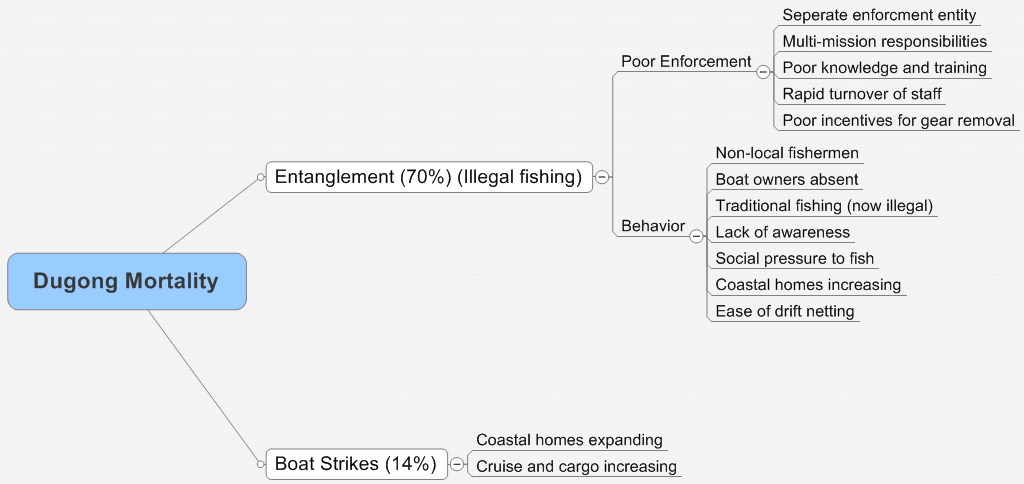Drivers, Pressures, State, Impact, Response (DPSIR): A model for targeted and effective conservation.
June 19, 2018
The Dugong and Seagrass Conservation Project is working with two policy specialists from the Environment Agency – Abu Dhabi. Meet the experts and learn more about applying policy analysis to dugong and seagrass conservation.
UPDATE: The Policy Gap Analysis Report has been completed since this news article was first posted. Download it here:
DPSIR Review Final 13 Feb 2019
psc
DSCP: Please introduce yourselves.
Peter:
My name is Peter Fippinger. I am a Senior Advisor for Priority Programs & Advisory Support Planning & Performance Management at the Environment Agency Abu Dhabi. I specialize in policy issues at EAD.
Simon:
My name is Simon Pearson. I am also a Senior Advisor for Priority Programs & Advisory Support Management Support Office. I work specifically on environmental policy issues at EAD.
What is a DPSIR analysis?
My name is Peter Fippinger. I am a Senior Advisor for Priority Programs & Advisory Support Planning & Performance Management at the Environment Agency Abu Dhabi. I specialize in policy issues at EAD.
My name is Simon Pearson. I am also a Senior Advisor for Priority Programs & Advisory Support Management Support Office. I work specifically on environmental policy issues at EAD.
The Driver, Pressure, State, Impact & Response (DPSIR) framework is a conceptual model, which can be used to define cause and effect relationships among the drivers (human needs), pressures (human activities), environmental state (negative trends), impacts (cascading social, environmental or economic changes), and responses (institutional policy and programs to improve conservation). The aim is to understand the real drivers which are sometimes unique to the local situation and then to identify and implement the most effective responses to remove or at least reduce the pressure.
Some benefits of this approach are 1) building a contextual understanding of cause and effect relationships, 2) identifying key gaps in understanding to prioritize research and monitoring, 3) identifying the key pressures and drivers that “if addressed” would provide the greatest conservation benefit, and 4) enabling prioritization of limited financial and human resources to the most impactful issues.
The DPSIR can be conducted by anyone who wants to better understand the cause and effect relationship around a conservation challenge.
What is its aim of conducting a DPSIR analysis?
The main aim of conducting a DPSIR analysis is to identify the most effective responses (projects, initiatives) to improve an ecological situation – remembering that the situation will only improve if the responses are effectively implemented and reinforced over time. Understanding the specific nature and motivations for human activities that are leading to a decline in ecological state is an important step to enable the implementation of the right response. Quite often with conservation work (and in other fields) we see well intentioned projects being implemented that have little positive impact on the situation. Resources for conservation are scarce and the use of the DPSIR can help ensure that we get the greatest improvement for the available resources.
Resources for conservation are scarce and the use of the DPSIR can help ensure that we get the greatest improvement for the available resources.
Who should conduct the DPSIR?
The DPSIR can be conducted by anyone who wants to better understand the cause and effect relationship around a conservation challenge. However, the team leading the development of the DPSIR will first need to identify the people with the data and information to understand the state (ideally with trends) and specifically for dugongs, data on the mortality and cause of mortality. This data along with the impact data is likely to be held by the local scientific community or NGO’s operating in the area. To understand the pressures and drivers will often require engaging with local communities and sometimes building their trust over time. The best responses are likely to be a result of engagement and negotiation between local communities and the sectors that benefit from the current way of doing things e.g. local fishing communities, and the national or local governments that need to develop laws and then enforce them. Without commitment and buy in from the parties with influence the responses are unlikely to be effective.
The best responses are likely to be a result of engagement and negotiation between local communities and the sectors that benefit from the current way of doing things
How has Abu Dhabi used a DPSIR approach?
While EAD already applies the DPSIR framework widely for “state of the environment” analysis and reporting, we piloted the guideline process and templates presented to the 3rd meeting of the EPSC with a cross-sector team within the Environmental Agency Abu Dhabi, who specifically lead dugong conservation locally.
We found that DPSIR analyses for dugong, and seagrass habitat, are better prepared separately, since those key cause and effect relationships may vary greatly between the two.
Specific to dugong mortality, we identified two (quantifiable) challenges – entanglement and boat strikes – and began to probe into the activities and motivations surrounding those issues. Boats strikes remains poorly understood (a future area of investigation), but entanglement is understood well enough to assess if current policy responses are addressing the key issues.

A review of the existing responses demonstrate that Abu Dhabi has a challenge with illegal fishing but that the regulatory framework is in place. Therefore, the team is now moving forward to further understand and influence the awareness and behavior of fishermen, and also to improve the performance capacity and behavior of the enforcement entity.

Are there any challenges to dugong & seagrass conservation, which are common to Abu Dhabi and the Dugong Project countries?
From the assessment we have done there seems to be a number of common pressures that are causing a decline in seagrass health and extent and dugong mortality leading to a decrease in population. For seagrass, coastal development, land use change, dredging, deterioration in marine water quality and fishing techniques cause damage, and entanglement in fishing gear and boat strikes directly impact dugong mortality. These pressures are likely to be present in most of the project countries.
However, even with common pressures the drivers can vary and reflect prevailing social, economic and political conditions in the different project areas and the maturity of regulation and enforcement activities. To reflect these differences the responses, or at least the way the responses are implemented, will need to be specific to each situation and work with the local social, community, government and regulatory structure.
We strongly recommend a commitment to the Dugong MoU.
Can there be a common and/ or joint response to the common conservation challenges across the countries?
For those not signatory to the CMS Memorandum of Understanding for the Conservation and Management of Dugong and Their Habitats Throughout Their Range, we strongly recommend a commitment to this agreement. Local partners play a key role in proposing and supporting governmental action for adoption and it’s a great way to exchange valuable information.
For the more common pressures such as entanglement in fishing gear we should develop solutions that work, share them and implement them as quickly as possible. There is a similar problem of sea turtles getting caught in trawl nets so TED’s (Turtle Excluder Devices) have been developed to provide an escape route for turtles. We need similar solutions for dugongs tailored for the different types of fishing gear as required.
Can you tell us some other areas that might benefit from common/joint response?
Community support for developing and implementing research projects and funding proposals necessary to fill key data and information gaps at the local levels through personnel and technology exchange.
Knowledge sharing of cases-studies and best practice around DPSIR analysis, policy gap analysis, research agenda development, conservation strategy development and specific sector plans (i.e. ecotourism) that are consistent with sustaining seagrass habitat and healthy dugong populations.

